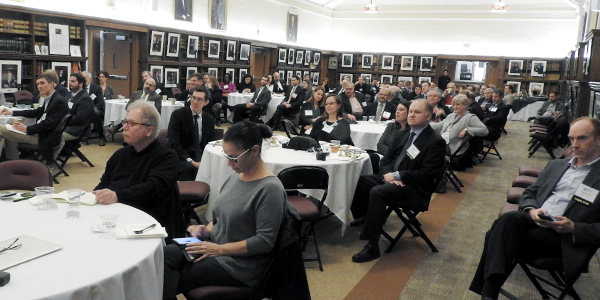By Michael Kuser
HARTFORD, Conn. — Lawmakers will this continue to focus this legislative session on efforts to transition the state to renewable energy and a carbon-neutral grid by 2040 while protecting ratepayers who already pay the highest electric bills in the continental U.S., industry participants heard Monday.

The CPES and Connecticut Bar Association hosted a legislative update in Hartford on Feb. 24. | © RTO Insider
Leaders of the General Assembly’s Energy and Technology Committee spoke to about 100 members of the Connecticut Power and Energy Society (CPES) and the state’s bar association at the University of Connecticut School of Law. The meeting came a month after Connecticut regulators convened a public hearing to examine whether ISO-NE’s wholesale electricity markets are effective in serving the state’s clean energy objectives. (See Connecticut Weighs Pros, Cons of ISO-NE Markets.) Public Utilities Regulatory Authority (PURA) Chair Marissa Gillett attended the discussion but did not comment.
Building on Success

“I think we’re going to try to continue and build on the successes that we had last year in our two major pieces of legislation, offshore wind and HB 5002,” said Rep. David Arconti (D), the committee’s co-chair, referring to a bill (HB 7156) authorizing the procurement of up to 2 GW of offshore wind and another authorizing procurement of energy derived from anaerobic digestion.
“A lot of our colleagues like to talk about energy in terms of what are we doing to address climate change, but when you get into the weeds of energy policy, it gets much more difficult to navigate those waters because there are so many other factors you have to consider,” Arconti said. “The top two obviously for me leading this committee are utility costs and the reliability of the grid.”

Rep. Charles Ferraro | © RTO Insider
“One of the things we do as legislators is try to stand on the cutting edge of technology and bring forward those policies that are going to help Connecticut, but at the same time look out for our ratepayers,” said Rep. Charles Ferraro (R), one of the ranking members on the committee.
“We’re very focused on moving us to a more renewable future, and Gov. Ned Lamont’s initiative for a carbon-free grid is something we’re trying to turn into policy in a reasonable way, knowing that Connecticut already has the highest electric rates in the country,” said Sen. Norm Needleman (D), co-chair of the committee. “Advancing that agenda without breaking the backs of people and businesses who live here is the dancing on the head of a pin that we’re trying to do.”
As for offshore wind, Needleman said Connecticut is uniquely positioned with two deepwater ports, Bridgeport and New London, which do not have bridges separating the piers from the open water.
“Connecticut has the opportunity to be a leader and the location for a lot of offshore wind deployment,” Needleman said.
Tech and Tax Solutions
Sen. Paul Formica (R), the other ranking member, could not attend Monday’s discussion but was quoted in The Connecticut Examiner in January as favoring energy storage as a solution to the variability of solar and wind.
Formica said he is “working with leaders in the energy sector on the mechanics of a bill that will incentivize the creation of ‘pockets’ of megawatt storage along the transmission line, which could prevent blackouts during major weather events,” the Examiner reported.

Leaders of the Connecticut General Assembly’s Energy and Technology Committee at the CPES meeting Feb. 24 (left to right): Sen. Norm Needleman, Democratic co-chair; Rep. Charles Ferraro, the ranking Republican representative; and Rep. David Arconti, Democratic co-chair. | © RTO Insider
Arconti said, “The goal of the bill is to bring the storage industry here to Connecticut, and storage is how we’re going to solve the intermittency issues of renewable energy.”
He said the legislation will contain “a very ambitious goal” of 1,000 MW of energy storage by 2030 “to mirror some of the programs we have with the offshore wind.” Lawmakers will also ask PURA to “leverage all the great work they’ve been doing on the grid modernization dockets, specifically the energy storage section,” he said.
Needleman brought up the need to tax commercial solar developers who he thinks enjoy an unfair property tax break on solar arrays between 1 and 5 MW, in many cases to the detriment of rural communities.

Sen. Norm Needleman | © RTO Insider
“I believe that the threshold at which we levy property tax is way too high, and a lot of those power plants are benefiting wealthier communities,” Needleman said.
He said he is working on legislation that would lower the tax threshold for commercial generation and would base the property tax only partly on project location in order to prevent developers from avoiding taxes.
Speaking about non-wires alternatives, microgrids and distributed energy resources, Needleman said he is “a big fan” of DER but thinks a microgrid powered by natural gas would conflict with public policy given the “big push to restrict the amount of natural gas we are using moving forward.”
“I have not been a huge fan of the state rushing headlong one way and now trying to do a gigantic reversal of policy that was put in place the last decade,” Needleman said. “It doesn’t make a lot of sense to set public policy with radical shifts. I think we need to be sensible. … We need realism, not just aspirational policy.”


